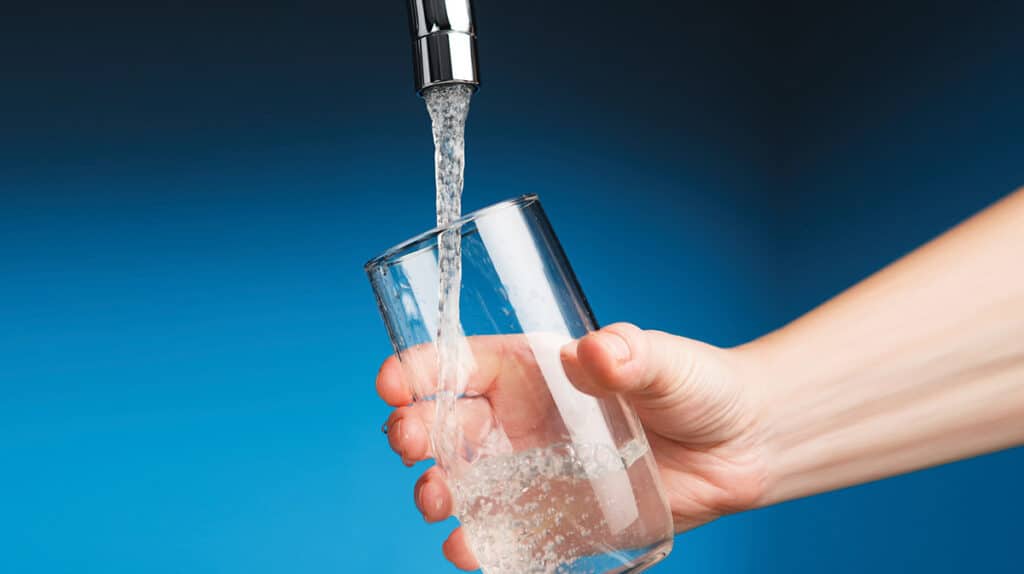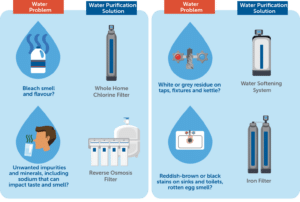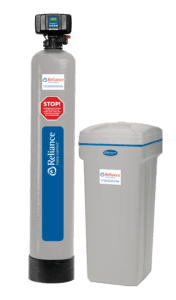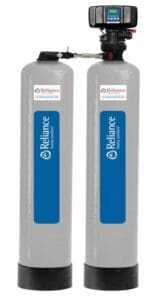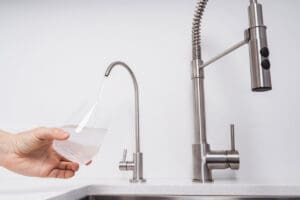A Complete Resource to Help Homeowners Understand Water Purification Options
Clean drinking water is necessary for life and health, and a growing number of homeowners want better quality water than they’re getting now.
Many effective options are available today to improve the quality of your home’s water supply. But, with so many options, it can difficult to know which solution is right for your particular water purification needs.
That’s where this guide comes in—as a resource to help you navigate the breadth of water purification options currently available in the marketplace today so you can make educated decisions on the solution that’s right for you and your home. And remember: you can always Call on Reliance™ to find the perfect solution for all of your water purification needs.
8 Things This Guide Will Answer
- What are the features and benefits of the most popular water purification systems on the market today?
- I’m experiencing specific problems with my home water supply. What can I do to resolve them?
- How do water purification systems work?
- Which water purification solutions make the most sense for my home?
- Should I consult with a water treatment advisor?
- What do I need to consider when purchasing a new water purification system?
- Which chemicals or minerals can impact the taste and smell of water?
- What is hard water and why should it be softened?
Quick-Start Troubleshooting Guide
The most common household water issues and the water treatment solutions to fix them
From bad-smelling water to stains on faucets and appliances, there’s a solution to handle most issues you may confront with your home water supply.
Whole Home Chlorine Filters
May improve the taste of your tap water and reduce the concentration of chlorine and other impurities in your home’s water supply.
Whole home chlorine filters (also called “whole home carbon filters”) are one of the simplest and most reliable solutions for some of the most common water quality concerns, including bleach smell and taste.
These days, chlorine is added to most municipal water supplies in order to kill micro-organisms, both at the treatment plant and along distribution pipes that bring water into your home. And while chlorine has been used to kill waterborne microbes for decades, it can infuse your water with the unpleasant taste and smell of bleach.
Tip: Know the Difference Between Chlorine and Chloramine
While chlorine is still the most common disinfectant used in municipal water supplies, a related compound called chloramine —which combines chlorine and ammonia—has gained popularity with some municipalities. Chloramine can provide longer-term, residual disinfection than chlorine, while also generating fewer by-products.
How they work:
Typically installed on the main incoming water line in a basement or utility room, water enters the filter’s housing, percolates through carbon particles, then leaves the filter. Impurities are bound by the carbon, while the resulting purified water flows from the filter to both the hot and cold sides of your household supply.
Choose from two types of whole home chlorine filters:
Backwashing-type-filters — cylinder-shaped pressure vessels sit on the floor in the basement or utility room.
- Active ingredients: Carbon particles—which look like coarse-ground coffee but are black in colour, not brown—sit loose in the bottom of the filter body.
- Benefits: One filter can handle all the water that flows through an average home for several years before carbon replacement is required. And, with regular maintenance and carbon replacement, a backwashing filter will easily last a very long time.
- A great choice: Coconut carbon—the highest-quality and most effective activated carbon for whole home filters.
Cartridge-style filters – smaller in size than backwashing filters, but the operating cost is higher (replacement filter cartridges are more expensive than loose carbon for the same duration of filtration activity). These filters are typically point of use and not whole home systems.
- Active ingredients: Carbon particles contained in a cartridge inserted into the filter body.
- Benefits: Most cartridge-style filter bodies can accept more than one type of cartridge.
- A great choice: A variety of cartridges are available to address specific filtration needs, whether you want to remove sediment, tannins or chlorine.
When it comes to installation, it’s best to consult with the pros.
Though it’s relatively simple for a licensed plumber to install, you’d be wise to book an in-home session with a Reliance Water Purification Advisor before deciding to have a whole home filter installed. This is especially important because your situation may involve more than just chlorine.
Whole-Home Chlorine Filters Features and Benefits
Can eliminate the chlorine taste and odour from each tap in your house for better tasting and smelling water
Long-lasting, high-quality activated carbon filter
Uses a high-quality regenerating valve for optimal filtration performance
An excellent addition to other Reliance Home Comfort water treatment solutions, such as water softeners

Water Softener Systems
What is hard water, and why does it need to be softened?
Water is considered hard or soft depending on its concentration of dissolved minerals, particularly magnesium and calcium ions. Some of the common reasons why people consider softening their household water supply:
- When water is too hard, it requires more soap for a given cleaning job.
- It can also cause your soap not to lather and for detergent residue to build up on your laundry.
- It can cause mineral build-up on taps, showers, baths and kettles.
- Your appliances could also wear out faster due to mineral buildup
Salt-Based Softeners
Also called “ion exchange water softeners”; effectively replace naturally occurring mineral ions in the water with other ions that don’t cause the same issues as hard water; salt must be added from time to time to recharge the internal resin bed that makes ion exchange happen,
TIP: Get to know the ways that water hardness is measured.
- gpg – grains per gallon
- mg/L – milligrams per litre
- ppm – parts per million
- mg/mL – milligrams per millilitre
Note: 1 gpg = approx. 17 mg/L
Key Considerations
- Salt consumption: The amount of salt you will need will depend on a variety of things. The salt needs to be added into a compartment in the softener, and the system regenerates automatically based on a pre-set schedule.
- Water usage: All salt-based softening systems use water that’s ultimately sent down the drain to complete the regeneration process.
- Flavour: Many people don’t like the taste of softened water, so they configure at least one cold water tap in the house (usually at the kitchen sink) to be fed with unsoftened water for drinking purposes.
- Bundling potential: If your water is moderately hard and you have a reverse osmosis (RO) system or plan to have one installed, consider a salt-based softener to treat the water before it goes into the RO unit. Pre-softening water may extend the working life of RO filter cartridges.
Water Softener Features & Benefits:
Stable, reliable and economical technology for salt-based softeners
Use less soap to get a good lather while doing away with built-up residue on sinks, bathtubs, kettles appliances, and more
Keep your fabrics brighter for longer
Enjoy the feel of softened water when bathing and taking a shower

Save More With Our Water Purification Offers!
Iron/Manganese Filters
Help deal with metallic-tasting water and rust stains in sinks and toilets
Iron and manganese compounds occur naturally in the groundwater of some areas;
Water with excess iron/manganese can appear clear at first but then develop colour and cloudiness after exposure to oxygen. The oxygen causes both the iron and manganese to settle in rust-like particles at the bottom of drinking glasses or pitchers, and these substances can also affect the taste of water.
Iron/manganese filters can remove higher iron concentrations (more than 5 mg/L). These should be installed in the water supply line ahead of any softening systems, as even fully dissolved elements can shorten the lifespan of the resin bed used in salt-based softeners if concentrations are too high.
How they work:
One of the simplest types of iron filters includes a single cylindrical tank with air in the top and a filter media at the bottom.
Iron and manganese in the water are oxidized by spraying it through the air in the tank. This causes the iron and/or manganese to drop out of the solution; the resulting rust-like particles are filtered out by the media at the bottom of the tank as the water flows through it on its way to your faucet and/or fixtures.
These systems automatically backwash every three or four days, flushing the precipitated iron/manganese out and down the drain.
Did you know?
As little as 0.3 mg/L of iron and 0.05 mg/L of manganese in water can cause staining on household plumbing fixtures.
Iron causes reddish-brown stains, black residue come from manganese.
Iron/Manganese Filter Features & Benefits:
Eliminate metallic taste in your water
Improve water clarity and odour
Reduce yellow, brown or black stains on plumbing fixtures, appliances and laundry

Reverse Osmosis (RO) Systems
Could help Improve the purity and taste of your home’s tap water
RO purification systems are designed to transform ordinary tap water into purified water.
The volume of water produced by most domestic RO systems is not sufficient to supply an entire house. Rather, typical RO systems are positioned under the kitchen countertop and have a dedicated faucet for drinking, cooking and washing dishes.
Did You Know?
The pore size of a typical RO filter is 0.0001 micron.
By comparison, a red blood cell measures 5 microns across and a human hair is about 75 microns in diameter.
How they work
Key to the RO treatment process is the fact that water molecules are small when compared with many other molecules. RO systems separate and trap undesirable substances from water as it’s pushed through a series of very fine membranes under pressure, leaving you with clean, filtered water.
RO systems typically come in two categories, which influences the type of filter mechanism used:
- Proprietary RO systems – use specific filters made by one particular company for their devices.
- Non-proprietary systems – use generic RO filters, made available by various suppliers to fit a range of different brands, often at a lower cost than proprietary filters.
Key considerations:
- Output and your water needs: All RO systems have a maximum output of filtered water; Consult with a water treatment advisor to select the right size of system for your home.
- Water usage: It can take 4 L of tap water sent down the drain to create 1 L of purified water using a RO system. This depends on several factors, including the system design, the temperature of the incoming water, and the pressure at which the water is delivered. (Note: If your household water pressure is 40 psi or lower, an auxiliary pump may be required to boost pressure enough for the RO system to operate effectively.)
- Filter changes: Filters should be changed on a regular basis as prescribed by the manufacturer.
- Bundling potential: Since RO systems offer such fine filtration, they usually come packaged with other filters for optimal water quality and purity. For instance, RO systems often include a sediment filter to protect membranes from being overloaded by large particles that may be present in the water. Carbon filtration is also often included as the last part of RO systems.
TIP: Sulphur and Reverse Osmosis systems don’t mix.
RO systems can’t remove hydrogen sulphide (the chemical that gives sulphur water its rotten egg smell). Its presence in your water supply can shorten the life of RO membranes.
Tip for choosing a RO system:
- Ask about the warranty period and coverage before you decide which unit to rent or buy.
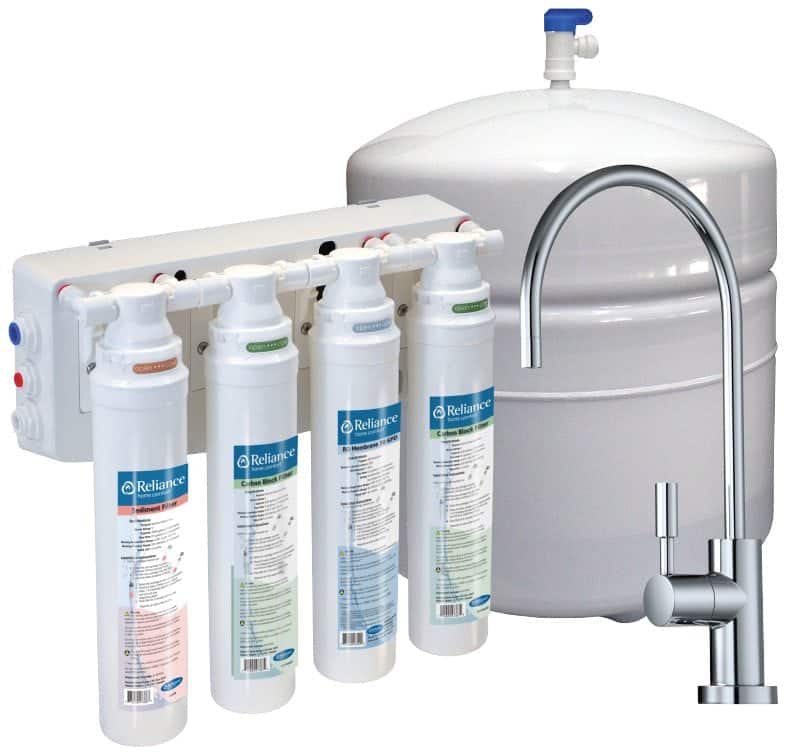
- Reliable production of filtered water removes a variety of common contaminants for cleaner, clearer and better-tasting water
- Large volume of daily output
- Quiet operation with countertop faucet design

Alkaline Filters
An under-sink alkaline water filtration system is like your home’s mini water treatment plant. It’s installed under your sink and works to help improve the purity
- Help to increase the pH levels in your drinking water.
- Help reduce impurities of your drinking water.
- Help reduce the use of single-use plastic water bottles.
- Help ensure consistent quality in every glass with advanced filtration technology!
- Help say goodbye to unpleasant odours and tastes in your tap water.

